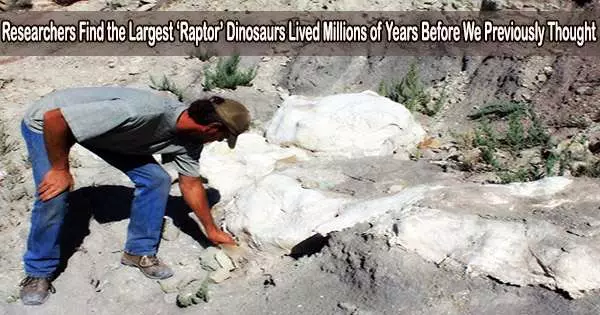Utahraptor is one of the largest raptors discovered so far. It lived during the Early Cretaceous period, approximately 126 million years ago. Utahraptor is going to need 10 million more candles on its next birthday cake. Estimates suggest that Utahraptor could reach lengths of up to 23 feet (7 meters) and weigh around 1,000 kilograms (2,200 pounds).
Geological analysis of the rock formation that included a fossilized specimen of the largest “raptor” in the world reveals that it is 10 million years older than previously thought. The report, which was co-written by a scientist from the University of Kansas, was just published in the Geosciences magazine.
“We determined the age of the dinosaur Utahraptor and found that it was much older than previously supposed,” said Gregory Ludvigson, emeritus senior scientist with the Kansas Geological Survey at KU, who collaborated on the investigation. “That finding has important implications for the evolutionary history of dinosaurs.”
The fieldwork took place in Utah at the well-known Utahraptor Ridge site, named for larger cousins of the ferocious velociraptor dinosaur (known to fans of “Jurassic Park”).
We determined the age of the dinosaur Utahraptor and found that it was much older than previously supposed. That finding has important implications for the evolutionary history of dinosaurs.
Gregory Ludvigson
Stikes Quarry, a quicksand deposit full of dinosaur fossils that are generally complete and preserved in nearly the same positions as when they died, is located on the ridge. The Cedar Mountain Formation, a geological unit that has more dinosaur fossils than any other formation in the world, includes Stikes Quarry.
“We also learned to our complete surprise that the rock strata from the Stikes Dinosaur Quarry were deposited during a global change episode known as the Weissert Event,” Ludvigson said. “This is an agenda-setting discovery that will reverberate for decades.”
More than a decade ago, Ludvigson, along with Jim Kirkland, state paleontologist with the Utah Geological Survey, and Matt Joeckel, state geologist and director of the Conservation and Survey Division at the University of Nebraska-Lincoln, joined together to tackle that question.
The scientists and colleagues they recruited took two research approaches: Zircon crystals were dated using uranium/lead by examining samples of these minerals that were taken from various depths in the rock strata. In the second, two kinds of stable carbon isotopes that are found in buried organic debris were examined for changes in relative abundance.
The scientists demonstrated that rocks in the Yellow Cat Member of the Cedar Mountain Formation and the Utahraptor fossils discovered there are 10 million years older than previously thought by comparing their findings to eras in Earth’s history during which it was known that the carbon cycle had undergone worldwide shifts.
Earlier estimates put the age of the rocks and fossils at 125 million years old.
“That’s a lot of evolutionary time,” Ludvigson said. “It’s kind of a vindication of something Jim’s argued for some time, but arguing doesn’t put an absolute age on it, and that’s important to him.”
According to the updated age, the Stikes Quarry rocks are at least 135 million years old. Even earlier strata are included in the Yellow Cat Member’s lower portion. The discoveries fill in the gap in Utah’s rock record at the juncture of the Jurassic and Cretaceous Periods.
“Before, we had a 25-million-year gap between them,” said Kirkland, who first named and described the dinosaur Utahraptor ostrommaysi in 1993. “That’s a third of the age of mammals, more than double the length of time for hominid evolution. It’s a big chunk of time. Anything can happen over 25 million years if you have no record of what’s going on. We’ve plugged that record, for the most part.”
















